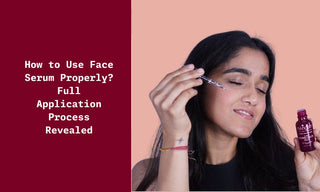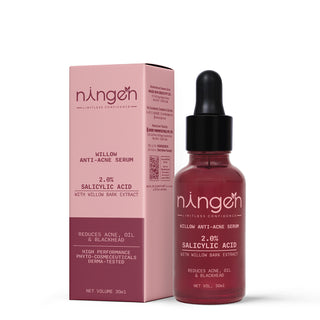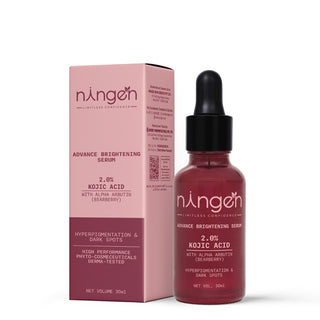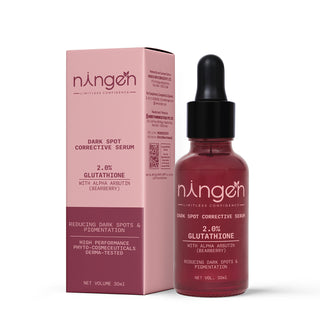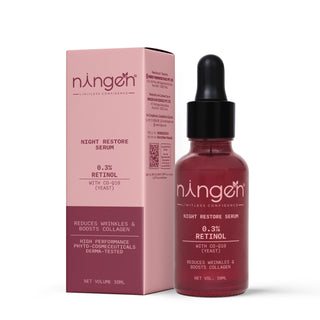“खूबसूरत स्किन गॉड गिफ्ट हो सकती है: लेकिन उसे हमेशा के लिए खूबसूरत बनने के लिए फेस सीरम का इस्तेमाल जरूर करें”
फेस सीरम ने स्किनकेयर की दुनिया में तहलका मचा दिया है, और इसका कारण है—सीरम में ऐसे पावरफुल इंग्रेडिएंट्स जो आपकी त्वचा की परेशानियों का हल करते हैं, जैसे डलनेस, फाइन लाइन्स, और आपकी त्वचा को निखारते हुए एक खूबसूरत ग्लो देते हैं। लेकिन क्या आप सही तरीके से सीरम का इस्तेमाल कर रहे हैं? क्या आपको पता है, की फेस सीरम को सही तरीके से एप्लाई करने से फर्क पड़ता है ? क्या आपको सीरम के पूरे फायदे मिल रहे हैं ? इस ब्लॉग में, हम आपको बताने जा रहे हैं, फेस सीरम क्या है,फेस सीरम को सही तरीके कैसे अप्लाई करें और बेहतर रिजल्ट कैसे पाए , ताकि आप इसके सारे फायदे उठा सकें।
In This Article;
- फेस सीरम क्या है?
- फेस सीरम कैसे लगाएं?
- फेस सीरम लगाने के सही तरीके
- फेस सीरम के फायदे
- सीरम के प्रकार
- सीरम लेयरिंग क्या है?
- सीरम के फायदे को अधिकतम कैसे करें
- फेस सीरम का अधिक उपयोग करने के जोखिम
- निष्कर्ष
- क्विक व्यू
- अक्सर पूछे जाने वाले प्रश्न
फेस सीरम क्या है?
फेस सीरम एक हल्का और जल्दी अब्जॉर्ब होने वाला लिक्विड है, जिसे स्किनकेयर में इस्तेमाल किया जाता है क्योंकि यह भारी क्रीम या लोशन के मुकाबले त्वचा के गहरे स्तर तक पहुंचाने में मदद करता है, सीरम में भारी क्रीम या मॉइश्चराइज़र के जैसे गाढ़े तत्व नहीं होते, जो त्वचा की सतह पर रुक जाएं। इसके बजाय, इसमें ऐसे ताकतवर इंग्रेडिएंट्स होते हैं जैसे विटामिन C, हायलूरोनिक एसिड, सैलिसिलिक एसिड या पेप्टाइड्स, जो छोटे अणुओं में होते हैं और आसानी से आपकी त्वचा के अंदर तक पहुँचकर असर दिखाते हैं।
सीरम पानी या तेल आधारित हो सकते हैं, यह इस बात पर निर्भर करता है कि उनका उद्देश्य क्या है और किस प्रकार की त्वचा के लिए बनाए गए हैं। उदाहरण के लिए, हायलूरोनिक एसिड से भरपूर सीरम आमतौर पर सूखी त्वचा के लिए उपयुक्त होता है, जबकि रेटिनॉल वाला सीरम झुर्रियों को कम करने और युवा त्वचा को बढ़ावा देने के लिए डिज़ाइन किया जाता है।
फेस सीरम कैसे लगाएं?
फेस सीरम का सही तरीके से उपयोग करना जरूरी है ताकि आप इसके पूरे फायदे पा सकें। यहां है एक सरल तरीका, जिससे आप सही तरीके से सीरम लगा सकते हैं:
फेस सीरम लगाने का स्टेप-बाय-स्टेप प्रोसेस
- चेहरा साफ करें : सबसे पहले, चेहरे को अच्छे से धोकर साफ करें। एक सौम्य क्लेंज़र का उपयोग करें, ताकि आपके चेहरे से गंदगी, तेल या मेकअप हट जाए।
- एक्सफोलिएट करें (ऑप्शनल) : हफ्ते में 2-3 बार एक्सफोलिएट करना मृत कोशिकाओं को हटाता है, जिससे सीरम गहरे तक पहुंच पाता है। हल्के एक्सफोलिएटर का इस्तेमाल करें अगर जरूरत हो।
- टोनर लगाएं: टोनर से अपने त्वचा का pH बैलेंस करें और इसे सीरम के लिए तैयार करें। यह विशेष रूप से तब मददगार होता है जब आपकी त्वचा तैलीय या मिश्रित हो।
- सीरम लगाएं : अपनी हथेली में 2-3 बूँदें सीरम की लें। इसे दोनों हाथों से हल्का सा रगड़ें ताकि सीरम गर्म हो जाए।
- उंगलियों से लगाएं: अब उंगलियों की मदद से सीरम को अपने चेहरे पर लगाएं। चेहरे के बीच से बाहर की ओर हल्के हाथों से लगाएं। इसे त्वचा में अच्छे से दबाएं—सख्ती से रगड़ने से बचें।
- गर्दन का ध्यान रखें : सीरम को गर्दन और डेकोलेटेज (चेस्ट) पर भी ऊपर की ओर स्ट्रोक्स से लगाएं। ये हिस्से भी सीरम के फायदे के हकदार हैं।
- सीरम को एब्जॉर्ब होने दें : सीरम को पूरी तरह से त्वचा में समाने दें। यह आमतौर पर 1-2 मिनट में हो जाता है।
- मॉइश्चराइज़र लगाएं : अब, एक अच्छा मॉइश्चराइज़र लगाएं, जो आपकी त्वचा के प्रकार के अनुसार हो। यह सीरम की गुडनेस को सील करने में मदद करता है और आपकी त्वचा को नरम रखता है।
- सनस्क्रीन लगाएं (सुबह की रूटीन) : अगर आप सुबह में सीरम लगा रहे हैं, तो हमेशा सनस्क्रीन लगाएं ताकि आपकी त्वचा यूवी किरणों से सुरक्षित रहे।
बेहतर रिजल्ट के लिए टिप्स :
- सीरम का नियमित रूप से इस्तेमाल करें, सुबह और रात को (दोनों समय) ताकि आपको अच्छे रिजल्ट मिल सकें।
- हमेशा उस सीरम को चुनें, जो आपकी त्वचा के मुद्दों पर फोकस करता हो, जैसे हाइड्रेशन, ब्राइटनिंग, और/या एंटी-एजिंग।
- फेस सीरम बहुत कम मात्रा में लगता है, तो जरूरत से ज्यादा न लगाएं—थोड़ा सा सीरम काफी होता है!
फेस सीरम लगाने के सही तरीके
चेहरे को पहले अच्छे से साफ करें
सीरम लगाने से पहले अपनी त्वचा को अच्छे से क्लीन करना बहुत जरूरी है। गुनगुने पानी और हल्के क्लेंजर से अपना चेहरा धोएं, ताकि गंदगी, तेल या मेकअप हट जाए। गुनगुना पानी रोमछिद्रों को खोलता है, जिससे सीरम आसानी से त्वचा में समा जाता है। चेहरे को रगड़ने की बजाय, हल्के हाथों से थपथपाकर सुखाएं, ताकि जलन न हो। जब चेहरा साफ हो, तो सीरम के एक्टिव इंग्रीडिएंट्स त्वचा में अच्छे से समा जाते हैं।
सीरम की सही मात्रा
फेस सीरम लगाने के लिए बस थोड़ी सी मात्रा, यानी एक मटर के दाने के बराबर या 2-3 ड्रॉप्स ही काफी होते हैं। सीरम बहुत पोटेंट होते हैं। आंखों के आसपास या स्पॉट ट्रीटमेंट्स के लिए और भी कम सीरम का इस्तेमाल करें, क्योंकि उनका कंसंट्रेशन ज्यादा होता है।
अगर आप एक से ज्यादा सीरम लगा रहे हैं, तो हमेशा पतले से मोटे वाले सीरम पहले लगाएं, और हर सीरम को अच्छे से अवशोषित होने का थोड़ा वक्त दें। सही मात्रा का इस्तेमाल करें, ताकि त्वचा में ओवरलोड न लगे।
सीरम को सही तरीके से लगाना
सीरम को सही तरीके से लगाना जरूरी है ताकि हर हिस्से को उसकी पूरी ताकत मिले। ये कुछ आसान स्टेप्स हैं:
- चेहरा साफ करें : सबसे पहले चेहरा अच्छे से धोएं। गुनगुने पानी और अपनी त्वचा के हिसाब से हल्के क्लेंजर का इस्तेमाल करें।
- चेहरा थपथपाकर सुखाएं : चेहरा धोने के बाद, तौलिए से हल्के हाथों से थपथपाकर सूखा लें। त्वचा को रगड़ें नहीं, नहीं तो जलन हो सकती है।
- सीरम लें : अपनी उंगलियों पर सीरम की थोड़ी सी मात्रा (जैसे मटर के दाने जितनी) लें।
- डॉट्स लगाएं : सीरम को माथे, गाल, ठोड़ी और नाक पर हलके-हलके डॉट्स की तरह लगाएं। इससे सीरम पूरे चेहरे पर बराबरी से फैलेगा।
- हल्के हाथों से फैलाएं : सीरम को हल्के ऊपर की ओर उठाते हुए चेहरे पर फैलाएं। त्वचा को खींचने से बचें। अगर किसी हिस्से में ज्यादा ध्यान देना है (जैसे uneven tone या खुले पोर्स), तो वहां थोड़ा ज्यादा लगाएं।
- थपथपाकर पैट करें : जब सीरम अच्छे से फैल जाए, तो हल्के हाथों से थपथपाकर उसे त्वचा में समा जाने दें।
सीरम लगाने के बाद हल्के गीले चेहरे पर सीरम लगाने से ज्यादा अच्छा असर होता है, और बाद में एक अच्छा मॉइश्चराइज़र लगाना न भूलें, ताकि सीरम के सारे फायदे त्वचा में लॉक हो जाएं। इस तरीके से आपकी त्वचा हाइड्रेटेड और ग्लोइंग रहेगी!
फेस सीरम के फायदे
फेस सीरम का इस्तेमाल आपके स्किनकेयर रूटीन में गेम-चेंजर साबित हो सकता है।क्योंकि इसके फायेदा बहुत सारे है :
गहरी हाइड्रेशन : सीरम में हायल्यूरोनिक एसिड जैसे हाइड्रेटिंग इंग्रीडिएंट्स होते हैं जो त्वचा में गहरे तक समा जाते हैं, जिससे त्वचा को गहरी नमी मिलती है और ड्राईनेस से बचाव होता है।
टार्गेटेड ट्रीटमेंट : सीरम में विटामिन C, रेटिनोल, और पेप्टाइड्स जैसे एक्टिव इंग्रीडिएंट्स होते हैं, जो विशेष त्वचा समस्याओं जैसे झुर्रियां, डार्क स्पॉट्स, और असमान त्वचा को ठीक करने में मदद करते हैं।
स्किन टोन को ब्राइट करना : कई सीरम में एंटीऑक्सीडेंट्स और ब्राइटनिंग एजेंट्स होते हैं, जो पिग्मेंटेशन को कम करने में मदद करते हैं और आपको एक चमकदार और ग्लोइंग त्वचा देते हैं।
फाइन लाइन्स और झुर्रियों को कम करना : एंटी-एजिंग सीरम में रेटिनोल और पेप्टाइड्स होते हैं, जो कोलेजन प्रोडक्शन को बढ़ाते हैं, जिससे फाइन लाइन्स और झुर्रियों का प्रभाव कम होता है।
हल्का और जल्दी अवशोषित होने वाला : भारी क्रीम के मुकाबले, सीरम हल्के होते हैं और जल्दी त्वचा में समा जाते हैं, जिससे सीधे गहरे स्तर पर पोषण मिलता है।
त्वचा की बनावट सुधारना : नियमित रूप से सीरम लगाने से त्वचा की बनावट सुधारती है, जिससे त्वचा मुलायम, तंग और समान टोन की बनती है।
स्किनकेयर रूटीन को बेहतर बनाना : सीरम दूसरे स्किनकेयर प्रोडक्ट्स जैसे मॉइश्चराइज़र और सनस्क्रीन के असर को बढ़ाता है, क्योंकि यह त्वचा को इन उत्पादों को बेहतर तरीके से अवशोषित करने के लिए तैयार करता है।
पोर को मिनिमाइज़ करना : सीरम में निआसिनामाइड जैसे इंग्रीडिएंट्स होते हैं, जो पोर्स को टाइट करने और एक्सेस ऑयल को कंट्रोल करने में मदद करते हैं, जिससे त्वचा का टेक्सचर स्मूथ लगता है।
त्वचा की रक्षा बढ़ाना : एंटीऑक्सीडेंट्स से भरपूर सीरम त्वचा को प्रदूषण और UV रेज़ जैसे पर्यावरणीय नुकसान से बचाते हैं, और जल्दी उम्र बढ़ने को रोकते हैं।
त्वचा को शांत और आरामदायक बनाना : सीरम में एलोवेरा और कैमोमाइल जैसे इंग्रीडिएंट्स होते हैं, जो त्वचा को ठंडक और शांति प्रदान करते हैं, और रेडनेस, इर्रिटेशन और सूजन को कम करते हैं।
सीरम का इस्तेमाल करने से आपकी त्वचा अधिक हेल्दी, ब्राइट और यंग दिखने लगेगी!
सीरम के प्रकार
फेसियल सीरम विशेष त्वचा समस्याओं को दूर करने के लिए डिज़ाइन किए गए कंसंट्रेटेड फॉर्मूले होते हैं। ये विभिन्न प्रकार के होते हैं, जो अलग-अलग जरूरतों के हिसाब से होते हैं:
- हाइड्रेटिंग सीरम: इसमें हायल्यूरोनिक एसिड और ग्लिसरीन जैसे इंग्रीडिएंट्स होते हैं, जो त्वचा में नमी बनाए रखते हैं और इसे ताजगी से भरते हैं।
- एंटीऑक्सीडेंट सीरम : ये सीरम विटामिन C या ग्रीन टी एक्सट्रैक्ट जैसे तत्वों से भरपूर होते हैं, जो त्वचा को पर्यावरणीय नुकसान से बचाते हैं और त्वचा को ब्राइट करते हैं।
- एंटी-एजिंग सीरम : रेटिनोल और पेप्टाइड्स जैसे इंग्रीडिएंट्स से भरे होते हैं, जो झुर्रियों को कम करते हैं और कोलेजन प्रोडक्शन को बढ़ाकर यंग लुक प्रदान करते हैं।
- ब्राइटनिंग सीरम : असमान त्वचा टोन को टार्गेट करने के लिए बने होते हैं, इन सीरम में विटामिन C, कोजिक एसिड, या निआसिनामाइड जैसे तत्व होते हैं, जो हाइपरपिग्मेंटेशन को कम करते हैं।
- एक्सफोलिएटिंग सीरम : इसमें AHA (Alpha-Hydroxy Acids) या BHA (Beta-Hydroxy Acids) जैसे तत्व होते हैं, जो त्वचा को एक्सफोलिएट करके पोर्स को रिफाइन करते हैं और स्किन टेक्सचर को सुधारते हैं।
- कैलमिंग सीरम : यह सेंसिटिव त्वचा के लिए आदर्श होते हैं, इन सीरम में सेंटीला एशियाटिका और एलोवेरा जैसे इंग्रीडिएंट्स होते हैं, जो रेडनेस और इर्रिटेशन को कम करते हैं।
फेस सीरम की मुख्य विशेषताएँ
फेस सीरम अपनी कंसंट्रेटेड और पोटेंट फॉर्मूले के कारण स्किनकेयर रूटीन में एक अहम हिस्सा बन गए हैं। उनकी मुख्य विशेषताएँ हैं:
- कंसंट्रेटेड फॉर्मूले : सीरम में एक्टिव इंग्रीडिएंट्स की ज्यादा मात्रा होती है, जो विशेष त्वचा समस्याओं (जैसे डार्क स्पॉट्स या एक्ने) को टार्गेट करते हैं। कम मात्रा में भी प्रभावी होते हैं।
- हल्की बनावट : कई सीरम हल्के होते हैं, जो भारी क्रीम या लोशन की बजाय त्वचा पर बिना कोई भारीपन डाले अच्छे से काम करते हैं।
- टार्गेटेड एक्शन : हर प्रकार की त्वचा समस्या के लिए सीरम उपलब्ध होते हैं, चाहे वो हाइड्रेशन हो, सेंसिटिविटी को शांत करना हो, टोन को ब्राइट करना हो या एंटी-एजिंग इफेक्ट्स।
- जल्दी असर दिखाना : सीरम की कंसंट्रेशन और बनावट के कारण, ये दूसरे स्किनकेयर प्रोडक्ट्स से जल्दी असर दिखा सकते हैं, खासकर जब इन्हें नियमित रूप से इस्तेमाल किया जाए।
- बेहतर अवशोषण : सीरम की मोलिक्यूलर संरचना ऐसी होती है, जिससे ये त्वचा के गहरे स्तर तक पहुंच कर एक्टिव इंग्रीडिएंट्स को ज्यादा प्रभावी तरीके से पहुंचाते हैं।
यहां तक कि थोड़ी सी मात्रा में सीरम आपके स्किनकेयर रूटीन को बेहतर बना सकता है और आपकी त्वचा को जल्दी और ज्यादा अच्छे परिणाम दे सकता है ।
सीरम लेयरिंग क्या है?
सीरम लेयरिंग वह प्रक्रिया है, जिसमें आप कई अलग-अलग सीरम का इस्तेमाल करते हैं, हर एक में विशिष्ट सक्रिय तत्व होते हैं, और इन्हें एक विशेष क्रम में लगाते हैं ताकि आपकी त्वचा की विभिन्न समस्याओं का एक साथ समाधान किया जा सके। सीरम लेयरिंग से आप हाइड्रेशन, एंटी-एजिंग, ब्राइटनिंग और एक्ने जैसी समस्याओं को एक ही रूटीन में टार्गेट कर सकते हैं।
सीरम लेयरिंग क्यों महत्वपूर्ण है?
- कई त्वचा समस्याओं को एक साथ टार्गेट करना : अलग-अलग सीरम में सक्रिय तत्व होते हैं जो विशेष समस्याओं को हल करते हैं। लेयरिंग से आप अपने स्किनकेयर रूटीन को कस्टमाइज कर सकते हैं और एक साथ फाइन लाइन्स, डलनेस और ड्राईनेस जैसी समस्याओं का समाधान कर सकते हैं।
- प्रभावशीलता बढ़ाना : जब सीरम सही तरीके से लेयर किए जाते हैं, तो वे एक-दूसरे के प्रभाव को बढ़ा सकते हैं। इससे त्वचा और अधिक पोषक तत्वों को अवशोषित कर पाती है और सीरम के फायदे अधिकतम हो जाते हैं।
- स्किनकेयर के लाभों को अधिकतम करना : सीरम को सही क्रम (आमतौर पर सबसे पतले से लेकर सबसे गाढ़े सीरम) में लगाने से यह सुनिश्चित होता है कि हर लेयर त्वचा में गहरे तक समा जाए और सक्रिय तत्व प्रभावी ढंग से काम करें।
- स्किन बैरियर को मजबूत करना : कुछ सीरम हाइड्रेशन और स्किन बैरियर को मजबूत करने पर ध्यान केंद्रित करते हैं, जबकि अन्य विशिष्ट समस्याओं को टार्गेट करते हैं। इन सीरम को लेयर करने से आपकी त्वचा को तात्कालिक और दीर्घकालिक लाभ मिलता है, जिससे त्वचा की सेहत में सुधार होता है।
- कस्टमाइज रूटीन : सीरम लेयरिंग आपको अपने रूटीन को त्वचा की बदलती जरूरतों के हिसाब से समायोजित करने की अनुमति देती है, जैसे मौसम के बदलाव या तनाव के दौरान, जिससे आपकी त्वचा संतुलित और स्वस्थ रहती है।
सीरम लेयरिंग के उदाहरण
यहां कुछ लोकप्रिय सीरम लेयरिंग रूटीन दिए गए हैं:
- हाइड्रेशन + ब्राइटनिंग + एंटी-एजिंग :
- स्टेप 1: हायल्यूरोनिक एसिड सीरम – सबसे पहले हाइड्रेटिंग सीरम लगाएं ताकि त्वचा को नमी मिले।
- स्टेप 2 : विटामिन C सीरम – फिर ब्राइटनिंग सीरम लगाएं, जो डार्क स्पॉट्स को टार्गेट करके चमक बढ़ाए।
- स्टेप 3: रेटिनोल या पेप्टाइड सीरम – एंटी-एजिंग सीरम से फाइन लाइन्स को कम करें और त्वचा की बनावट को सुधारें।
- एक्ने कंट्रोल + सूसिंग + हाइड्रेशन :
- स्टेप 1 : सैलिसिलिक एसिड सीरम – सबसे पहले एक्ने-फाइटिंग सीरम लगाएं, जो पोर्स को खोलकर ब्रेकआउट्स को कम करता है।
- स्टेप 2: निआसिनामाइड सीरम – फिर सूसिंग सीरम लगाएं, जो त्वचा की जलन और रेडनेस को कम करता है।
- स्टेप 3: हायल्यूरोनिक एसिड सीरम – त्वचा को हाइड्रेट करने के लिए हाइड्रेटिंग सीरम लगाएं।
- इवन स्किन टोन + हाइड्रेशन & स्किन ब्राइटनिंग :
- स्टेप 1 : अल्फा आर्बुटिन सीरम – पिग्मेंटेशन को टार्गेट करने वाला सीरम लगाएं।
- स्टेप 2: हायल्यूरोनिक एसिड सीरम – हाइड्रेटिंग सीरम लगाकर त्वचा को नमी दें और इसे ब्राइट करें।
- एक्सफोलिएशन + हाइड्रेशन + रिपेयर :
- स्टेप 1 : ग्लाइकोलिक एसिड सीरम – सबसे पहले एक्सफोलिएटिंग सीरम लगाकर डेड स्किन को हटाएं।
- स्टेप 2 : हायल्यूरोनिक एसिड सीरम – हाइड्रेटिंग सीरम लगाकर खोई हुई नमी को फिर से भरें।
- स्टेप 3: सेरामाइड या रिपेयर सीरम – रिपेयर सीरम से स्किन बैरियर को मजबूत करें और हाइड्रेशन को लॉक करें।
- एंटीऑक्सीडेंट प्रोटेक्शन + हाइड्रेशन + एंटी-पॉल्यूशन :
- स्टेप 1 : विटामिन C या फेरुलिक एसिड सीरम – एंटीऑक्सीडेंट सीरम लगाएं ताकि पर्यावरणीय नुकसान से बचाव हो।
- स्टेप 2 : हायल्यूरोनिक एसिड सीरम – फिर हाइड्रेटिंग सीरम लगाकर नमी बनाए रखें।
- स्टेप 3 : एंटी-पॉल्यूशन सीरम – पॉल्यूशन और ऑक्सीडेटिव स्ट्रेस से बचाने वाला सीरम लगाएं।
सीरम लेयरिंग के लिए टिप्स
- सही क्रम में लगाएं: हमेशा सबसे हल्के (वॉटर बेस्ड) सीरम से लेकर सबसे मोटे (गाढ़े) सीरम तक लगाएं।
- हर सीरम को पूरी तरह से अवशोषित होने दें: एक सीरम लगाने के बाद, उसे पूरी तरह से अवशोषित होने का समय दें फिर अगले सीरम को लगाएं।
- प्रोडक्ट्स को पहले टेस्ट करें: यह सुनिश्चित करने के लिए कि वे एक-दूसरे के साथ ठीक से काम करते हैं और जलन नहीं करते, हर प्रोडक्ट को पहले अलग-अलग टेस्ट करें।
सीरम के फायदे को अधिकतम कैसे करें
- सही सीरम का चयन करें: अपने त्वचा की समस्याओं को टार्गेट करने वाले सीरम का चयन करें। उदाहरण के लिए, विटामिन C सीरम पिग्मेंटेशन को कम करने में मदद करता है, जबकि रेटिनोल सीरम फाइन लाइन्स को कम करता है।
- गीली त्वचा पर लगाएं: सीरम को थोड़ा गीला रहने वाले चेहरे पर लगाएं, ताकि अवशोषण बेहतर हो सके।
- सही तरीका अपनाएं: सीरम को अपनी उंगलियों के बीच गर्म करके लगाएं, इससे इसे अच्छे से फैलाने और त्वचा में समाने में मदद मिलती है।
- ओवर-अप्लाई न करें: क्योंकि सीरम कंसंट्रेटेड होते हैं, ज्यादा लगाने से कोई फर्क नहीं पड़ेगा, बल्कि यह वेस्ट हो सकता है और त्वचा पर जमा हो सकता है।
सीरम कितनी बार लगाएं?
सीरम की आवृत्ति इस पर निर्भर करती है कि वह किस प्रकार का सीरम है और आपकी त्वचा की जरूरत क्या है। सामान्य रूप से:
- ड्राई त्वचा के लिए: हाइड्रेटिंग सीरम का इस्तेमाल दिन में दो बार किया जा सकता है।
- एंटीऑक्सीडेंट सीरम : विटामिन C जैसे सीरम आमतौर पर सुबह लगाया जाता है, ताकि पूरे दिन पर्यावरणीय नुकसान से बचाव हो सके।
- एक्सफोलिएटिंग सीरम: इनमें मौजूद एसिड को रात में और दिन में एक बार से ज्यादा इस्तेमाल नहीं करना चाहिए।
- रेटिनोल सीरम : रेटिनोल सीरम आमतौर पर रात में लगाते हैं, क्योंकि इससे त्वचा सूर्य की किरणों के प्रति अधिक संवेदनशील हो जाती है।
फेस सीरम का अधिक उपयोग करने के जोखिम
फेस सीरम में विटामिन C, सैलिसिलिक एसिड और रेटिनोल जैसे शक्तिशाली सक्रिय तत्व होते हैं, लेकिन इनका अधिक उपयोग त्वचा के बैरियर को नुकसान पहुँचा सकता है और जलन, ब्रेकआउट्स, या ड्राईनेस जैसी समस्याएँ पैदा कर सकता है, जो आपकी त्वचा के प्रकार पर निर्भर करती हैं। संवेदनशील त्वचा में लालपन हो सकता है, तैलीय त्वचा में पोर्स बढ़ सकते हैं या एक्ने हो सकता है, और ड्राई त्वचा में और अधिक निर्जलीकरण हो सकता है। अगर आप अपने स्किनकेयर रूटीन में बहुत सारे सीरम डालते हैं, तो यह त्वचा की बनावट को प्रभावित कर सकता है और वित्तीय रूप से भी नुकसान हो सकता है। स्वस्थ त्वचा बनाए रखने के लिए हमेशा सीरम का उपयोग निर्देशों के अनुसार करें, सही मात्रा और आवृत्ति का ध्यान रखें।
निष्कर्ष
आशा है कि आपको फेस सीरम के सही उपयोग के बारे में यह लेख मददगार लगा होगा। फेस सीरम का सही तरीके से उपयोग आपके स्किनकेयर रूटीन को काफी बेहतर बना सकता है, और यह त्वचा की विशिष्ट समस्याओं को हल करने के लिए लक्षित लाभ प्रदान करता है। हाइड्रेशन, ब्राइटनिंग, एंटी-एजिंग और सूसिंग—सीरम स्वस्थ, चमकदार त्वचा के लिए शक्तिशाली सहायक होते हैं। सही आवेदन विधियों का पालन करने और सीरम की लेयरिंग को समझने से उनके प्रभावशीलता को अधिकतम किया जा सकता है। याद रखें, थोड़ा सा काफी होता है—सही मात्रा का उपयोग करें और ऐसे सीरम चुनें जो आपकी त्वचा के प्रकार और आवश्यकताओं के अनुसार हों ताकि बेहतरीन परिणाम मिल सकें।
क्विक व्यू
फेस सीरम संकेंद्रित स्किनकेयर उत्पाद होते हैं जो हाइड्रेशन, एंटी-एजिंग और ब्राइटनिंग जैसी विशिष्ट समस्याओं को टार्गेट करते हैं। सही तरीके से सीरम का उपयोग करने के लिए, अपनी त्वचा को साफ करें, 2-3 बूँद सीरम लगाएं और फिर मॉइश्चराइज़र लगाएं। सीरम का नियमित उपयोग करें और उन्हें सही तरीके से लेयर करें ताकि इसके लाभ अधिकतम हो सकें। अधिक उपयोग से बचें ताकि त्वचा में जलन न हो, और हमेशा ऐसे सीरम का चयन करें जो आपकी त्वचा की विशेष जरूरतों को पूरा करें।
अक्सर पूछे जाने वाले प्रश्न
Q1. मैं फेस सीरम सही तरीके से कैसे लगाऊं?
अपनी त्वचा को साफ करें, सीरम की कुछ बूँदें समान रूप से लगाएं, और फिर हल्के से त्वचा में पैट करें। इसके बाद मॉइश्चराइज़र लगाएं।
Q2. क्या मैं एक साथ एक से अधिक सीरम इस्तेमाल कर सकता हूँ?
हां, आप सीरम को लेयर कर सकते हैं। सबसे पतला सीरम पहले लगाएं और फिर अगले सीरम को लगाने से पहले हर लेयर को अवशोषित होने दें।
Q3. मुझे फेस सीरम कितनी बार लगाना चाहिए?
अधिकांश सीरम एक या दो बार दैनिक रूप से लगाए जा सकते हैं, यह उनके तत्वों और आपकी त्वचा के प्रकार पर निर्भर करता है।
Q4. क्या मुझे सीरम लगाने के बाद मॉइश्चराइज़र की आवश्यकता है?
हां, मॉइश्चराइज़र सीरम के लाभों को सील करने और त्वचा को हाइड्रेटेड रखने में मदद करता है।
Q5. सीरम की सही मात्रा कितनी होनी चाहिए?
आमतौर पर, 2-3 बूँद या मटर के आकार के बराबर मात्रा चेहरे और गर्दन के लिए पर्याप्त होती है।
Q6. क्या अधिक सीरम लगाने से मेरी त्वचा को नुकसान हो सकता है?
सीरम का अधिक उपयोग जलन, ब्रेकआउट्स, या ड्राईनेस का कारण बन सकता है, जो आपकी त्वचा के प्रकार पर निर्भर करता है।
Q7. मुझे सबसे पहले कौन सा सीरम लगाना चाहिए?
हमेशा सीरम को सबसे हल्के से लेकर सबसे मोटे सीरम तक लगाएं ताकि अवशोषण अधिकतम हो सके।
Q8. क्या फेस सीरम सभी त्वचा प्रकारों के लिए उपयुक्त होते हैं?
हां, हर त्वचा प्रकार के लिए अलग-अलग सीरम होते हैं, जिसमें संवेदनशील, ड्राई, तैलीय और मिश्रित त्वचा के लिए सीरम शामिल हैं।
Q9. क्या मुझे दिन और रात के लिए अलग सीरम की जरूरत है?
कुछ सीरम, जैसे विटामिन C, सुबह उपयोग के लिए बेहतर होते हैं, जबकि रेटिनोल और एक्सफोलिएटिंग सीरम आमतौर पर रात में उपयोग किए जाते हैं।
Q10. मुझे सीरम और मॉइश्चराइज़र लगाने के बीच कितनी देर इंतजार करना चाहिए?
सीरम को अवशोषित होने के लिए लगभग 1-2 मिनट का समय दें, फिर मॉइश्चराइज़र लगाएं।


